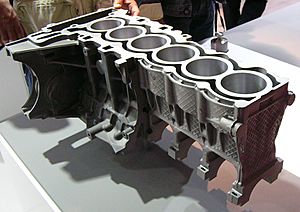Die casting facts for kids
Die casting is a cool way to make metal parts. It works by pushing hot, melted metal into a special mold. Think of it like a giant injection mold for plastic, but for metal!
The mold is made from two strong pieces of tool steel. These pieces are shaped very carefully. When they close, they form the exact shape of the part you want to make.
Most die-cast parts are made from metals that don't have iron. These are called non-ferrous metals. Common metals used include zinc, copper, aluminium, magnesium, lead, pewter, and tin alloys. The type of metal helps decide which machine to use: a hot-chamber or cold-chamber machine.
Die casting machines and molds can be expensive to start with. But once they are set up, making parts is very fast and simple. It usually only takes four main steps. This makes die casting great for making lots of the same item, which helps keep the cost of each part low. Many small to medium-sized metal parts are made this way. Die-cast parts also look very smooth and have a very exact size.
Contents
How Die Casting Works
Die casting is a quick and efficient way to shape metal. It involves a few key steps to turn liquid metal into a solid, finished part.
The Mold: Dies
The most important part of die casting is the mold, which is called a "die."
- A die is made from two strong pieces of tool steel.
- These pieces are machined to create the exact shape of the part.
- They fit together perfectly, like a puzzle, to form a closed cavity.
Melting the Metal
Before casting, the metal needs to be melted.
- Metals like aluminum, zinc, or magnesium are heated until they become liquid.
- The temperature depends on the metal, but it's always very hot!
Injecting the Metal
Once the metal is liquid, it's injected into the die.
- A powerful machine forces the melted metal into the closed die cavity.
- This happens very quickly and under high pressure.
- The pressure ensures the metal fills every tiny detail of the mold.
Cooling and Ejecting
After injection, the metal cools down and hardens inside the die.
- The die is often cooled with water to speed up this process.
- Once the metal is solid, the two halves of the die open up.
- The newly formed metal part is then pushed out by ejector pins.
Why Die Casting is Used So Much
Die casting is one of the most popular ways to make metal parts. It has many benefits that make it a top choice for manufacturers.
Making Many Parts Quickly
Die casting is perfect for mass production.
- It can make thousands of parts in a short amount of time.
- This speed helps companies produce many items for cars, electronics, and toys.
Strong and Smooth Parts
Parts made by die casting are usually very strong.
- They also have a smooth surface finish.
- This means they often don't need much extra work to make them look good.
Exact Sizes and Shapes
Die casting creates parts with very precise dimensions.
- This is important for parts that need to fit together perfectly.
- For example, parts for engines or electronic devices need to be exact.
What Die Cast Parts Are Used For
You might be surprised how many things around you are made using die casting!
- Cars: Many parts in car engines, wheels, and other components are die-cast.
- Electronics: Parts for phones, computers, and cameras often use die-cast metal.
- Home Appliances: Parts in washing machines, blenders, and vacuum cleaners can be die-cast.
- Toys: Some durable metal toys, like model cars, are made this way.
Images for kids
See also
 In Spanish: Fundición a presión para niños
In Spanish: Fundición a presión para niños




